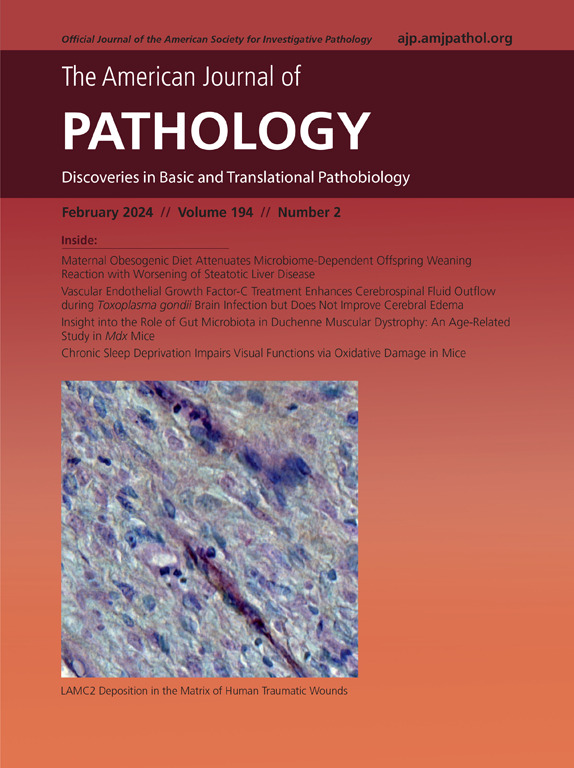Müller胶质细胞的昼夜节律对视网膜平衡和神经元存活至关重要
IF 4.7
2区 医学
Q1 PATHOLOGY
引用次数: 0
摘要
通过调节局部昼夜节律钟,全身的生物过程在时间上协调一致。视网膜是新陈代谢最活跃的组织之一,其需求在很大程度上取决于光/暗周期。已知啮齿类动物视网膜内的大多数细胞类型都能表达昼夜节律时钟,但人类视网膜时钟的表达以前尚未定位。此外,局部昼夜节律时钟功能障碍对视网膜稳态的影响尚不完全清楚。我们证明了人类视网膜中昼夜节律钟基因和蛋白质表达的下降与年龄有关。利用靶向 Bmal1 缺乏的动物模型,我们发现视网膜 Müller 胶质体的昼夜节律钟对神经元存活、血管完整性和视网膜功能至关重要。这些结果表明,视网膜 Müller 胶质中的局部昼夜节律钟在与年龄相关的视网膜疾病和视网膜退化中可能扮演着重要角色。本文章由计算机程序翻译,如有差异,请以英文原文为准。
The Circadian Clock of Müller Glia Is Necessary for Retinal Homeostasis and Neuronal Survival
Biological processes throughout the body are orchestrated in time through the regulation of local circadian clocks. The retina is among the most metabolically active tissues, with demands depending greatly on the light/dark cycle. Most cell types within the rodent retina are known to express the circadian clock; however, retinal clock expression in humans has not previously been localized. Moreover, the effect of local circadian clock dysfunction on retinal homeostasis is incompletely understood. The current study indicated an age-dependent decline in circadian clock gene and protein expression in the human retina. An animal model of targeted Bmal1 deficiency was used to identify the circadian clock of the retinal Müller glia as essential for neuronal survival, vascular integrity, and retinal function. These results suggest a potential role for the local retinal circadian clock within the Müller glia in age-related retinal disease and retinal degeneration.
求助全文
通过发布文献求助,成功后即可免费获取论文全文。
去求助
来源期刊
CiteScore
11.40
自引率
0.00%
发文量
178
审稿时长
30 days
期刊介绍:
The American Journal of Pathology, official journal of the American Society for Investigative Pathology, published by Elsevier, Inc., seeks high-quality original research reports, reviews, and commentaries related to the molecular and cellular basis of disease. The editors will consider basic, translational, and clinical investigations that directly address mechanisms of pathogenesis or provide a foundation for future mechanistic inquiries. Examples of such foundational investigations include data mining, identification of biomarkers, molecular pathology, and discovery research. Foundational studies that incorporate deep learning and artificial intelligence are also welcome. High priority is given to studies of human disease and relevant experimental models using molecular, cellular, and organismal approaches.

 求助内容:
求助内容: 应助结果提醒方式:
应助结果提醒方式:


